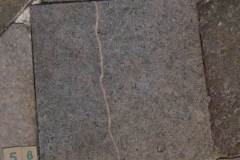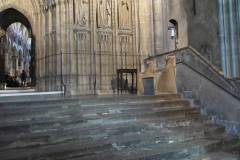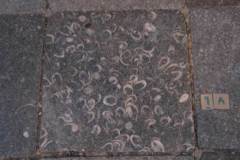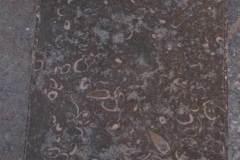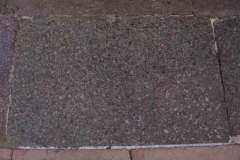Basics
Geology: Durlston Formation
Rock unit: Shelly freshwater-brackish limestone
Age: Lower Cretaceous
Provenance: Isle of Purbeck
Where to see examples
- north choir aisle (image 1)
- steps beneath crossing (images 2-4)
- south east transept (image 5)
Description
The Durlston Formation consists of a number of interbedded sedimentary limestones and mudstones laid down in a shallow lagoonal environment with salinities ranging from freshwater to hypersaline. The different beds represent slightly different conditions for deposition each with its own community of plants and animals partly preserved today as the fossil content. It is the limestones in these beds that have been quarried and cut into slabs and used for much of the paving east of the nave. These beds include the more distinctive stone known as Purbeck Marble. Only those beds which contain significant proportions of Viviparus shells are recognised as Purbeck Marble. Other limestone beds from this Formation are best described as Purbeck limestone.
The paving slabs differ in appearance depending on their mineralogy and their fossil content. The most common shell material contains Unio and Viviparus an assemblage indicative of freshwater – brackish water conditions. Viviparus is a genus of snail with a distinctive coiled shell. Unio is a bivalve and a genus of medium-sized mussel.
The matrix between the fossil shells is micrite, a lime mud. Secondary deposition of calcium carbonate forms the mineral calcite commonly seen as distinct white crystals such as those seen within the snails.
The Purbeck limestones are quarried today for building stone and floorings. Several types of stone are recognised as suitable for paving because of their appearance and durability and the ability to be split into thin slabs. As part of the restoration of the nave floor in the early 1990s the partial concrete paving of the South West Transept was replaced with a stone from Purbeck chosen to match the colour of the pavings in the choir.
Several varieties of stone were available at the time quarried from distinctive beds from the Freestone Vein within the Durlston Formation. These local beds are given specific and colourful names in the stone sales brochures such as Purbeck Burr, Purbeck Thornback, Purbeck Grub and Purbeck Spangle. In the South West transept the material used was Purbeck Grub, a bluish-brown limestone with a dense fossil content. In each square of stone can be seen cross-sections through numerous broken shells, many being those of oysters. The stone was able to take a good polish. Purbeck Grub has been used elsewhere in floors including Southwark Cathedral and the visitor’s reception area at Windsor Castle.

